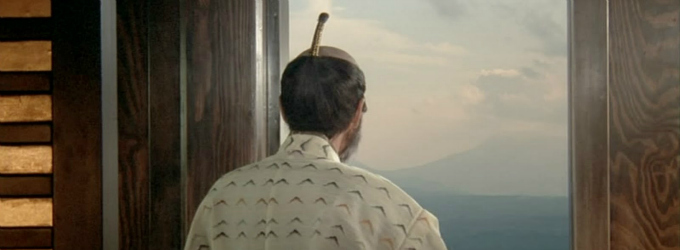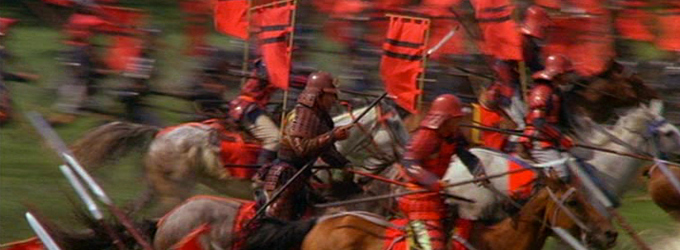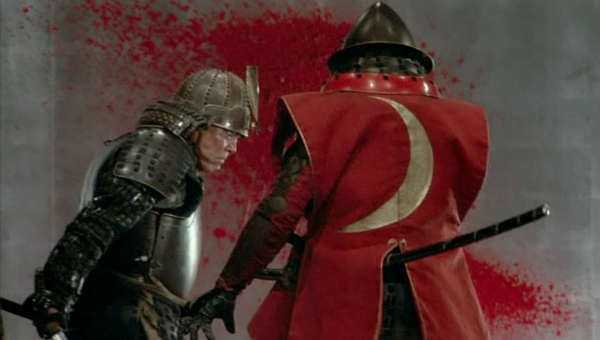 John Cleese and Graeme Garden used to make management training videos that were effective because they were entertaining. If anyone ever mooted an MBA programme in which great movies were used to the same end, then Kurosawa’s RAN could happily sit in the “Succession Planning for Chief Executives” module along side THE GODFATHER and THERE WILL BE BLOOD. The Cleese/Garden films worked because they showed you people making every mistake under the sun. They were light comedy, but while Hidetora (Tatsuya Nakadai, alienated from the viewer by mask-like makeup that borders on face-paint) does take the wrong alternative in almost every decision he makes, he does so in the mode of high tragedy.
John Cleese and Graeme Garden used to make management training videos that were effective because they were entertaining. If anyone ever mooted an MBA programme in which great movies were used to the same end, then Kurosawa’s RAN could happily sit in the “Succession Planning for Chief Executives” module along side THE GODFATHER and THERE WILL BE BLOOD. The Cleese/Garden films worked because they showed you people making every mistake under the sun. They were light comedy, but while Hidetora (Tatsuya Nakadai, alienated from the viewer by mask-like makeup that borders on face-paint) does take the wrong alternative in almost every decision he makes, he does so in the mode of high tragedy.
This is what it is to be a leader. You become a force of nature.
Kurosawa artfully intermingles huge landscapes, luscious or bleak, with interiors that mingle austerity with intimacy. Small groups have short conversations indoors, but these short conversations are stretched in time through long, static silences. Outside, they launch mighty forces (more than a thousand extras) into bloody conflict. Cutaways to mounting storm clouds symbolise the accumulating destructive energy. This is what it is to be a leader. You become a force of nature. How will you deploy your force? Hidetora has wearied of that responsibility and tries to pass it on to his sons while keeping the trappings, the pomp and privilege, that would go with it. An untenable position. How will you ensure your legacy? He picks the wrong son to lead the clan: the pompous but weak Taro (literally “First Son”), and not the stroppy but loyal Saburo (“Third Son”). Meanwhile, Lady Kaede (a deeply unnerving performance by Mieko Harada) filled with quiet menace and power, uses the chaos created by Hidetora’s error to wreak long-delayed revenge upon him and his house.
The first time we see a Kurosawa film in colour it seems distracting, unnecessary. What did the monochrome photography of his earlier masterpieces leave unsaid? Little. But in RAN the screen is often filled with large fields of solid colour. The three sons and their armies have signature colours, manifested in gorgeously rich clothes for the brothers, and in uniform armour and flags for their armies. This, combined with the common use of very long shots, tends to turn characters into symbols. Notwithstanding their occasional idiosyncratic flashes, and their complex intertwined personal histories, most of the characters are more like signs. They each stand for a different aspect of Hidetora’s folly, error and hubris.
This sort of thing can get out of control with a heavy-handed director, and many films made contemporaneously with RAN seem to reveal a great confusion in the film-maker over what is satisfyingly rich symbolism and what is indulgent tosh. Kurosawa, of course, cuts through this like a feudal lord cutting through a rival’s neck. The symbolic elements in RAN are not lost in a mulch of obscurantism, the symbols are insistently thrust at us on the screen, like blood up a wall, forcing us into a cool intellectual appraisal of bloody vengeance, betrayal, and moral collapse. Executive MBAs, take note.
httpvh://youtu.be/v8SSR_qcql8


One of my favourite films! Wonderful review. Interesting point about the storm clouds, and thanks for the translations of the names! Mieko Harada is indeed utterly chilling. A question, though – why no mention of the fact that it’s a Shakespeare adaptation? I feel that this illuminates the film’s structural configuration, and enriches the work thanks to its historical and cross-cultural applicability (although you sort of covered that last point in your intro).
Hi as2191,
Thanks for your kind words. I was in two minds about mentioning the Lear thing.
Eventually I came down against as it is I my understanding that Kurosawa (claimed that he) never meant to adapt Lear, he meant to adapt a likely apocryphal story about Môri Motonari: the so-called “Lesson of the Three Arrows”. This ended up coverging with the Lear story. There’s more than a hint of Macbeth, too, of course.